Arthur George Walker
| Arthur George Walker | |
|---|---|
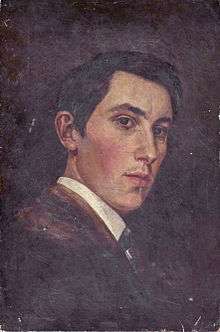 Self portrait | |
| Born |
20 October 1861 Hackney, London |
| Died |
13 September 1939 England |
| Known for | Sculpture, relief, illustration |
Arthur George Walker RA (1861–1939) was an English sculptor and painter. Among his best-known works are the Derby War Memorial and the statue of Florence Nightingale at Waterloo Place, London.
Personal life
Arthur George Walker was born 20 October 1861 to Robert Walker and his wife in Hackney, London. Robert Walker was a ship owner and surveyor.[1] Until 1911, Walker lived with his Aunt Isabella and two siblings, Emily and Harold. He died on 13 September 1939 in England.[1] He studied at the Royal Academy from about 1883 to 1887 and during this time won various prizes.[1]
The following are details of some of Walker's many works.
War Memorials
| Work | Location | Notes and References |
|---|---|---|
| Heath Town War Memorial | Heath Town West Midlands | This memorial, situated in the centre of Heath Town Park, has a bronze sculpture by Walker depicting a soldier and some relief panels on the side of the memorial's pedestal. One of the relief panels shows an aeroplane taking off and the other depicts a naval scene. The bronze casting work involved was carried out by the G.Fiorini Foundry.[2][3] |
| Ironbridge War Memorial | Ironbridge Shropshire | The Ironbridge War Memorial is located close to the famous Ironbridge and features a life size sculpture of a soldier in full marching order. The soldier stands on a pedestal. There are three plaques attached to the memorial. One is inscribed ” IN GRATEFUL/ AND UNDYING MEMORY/ OF THE VALIANT MEN/ OF IRON BRIDGE/ WHO LAID DOWN/ THEIR LIVES/ IN THE GREAT WAR/ 1914 – 1919/ WE THANK OUR GOD UPON/ EVERY REMEMBRANCE OF YOU”the second lists the names of those 53 Ironbridge men lost in the Great War and the third is inscribed ” THE CHURCH CLOCK WAS/ ILLUMINATED AS A MEMORIAL/ TO THE FOLLOWING MEN OF/ IRONBRIDGE WHO LOST THEIR LIVES DURING THE 1939-1945 WAR./(10 names)”The memorial was unveiled on 8 March 1924 by Col.A.N.B.Garrett.[4][5] |
| Heston War Memorial | Heston Middlesex | Heston War Memorial stands in a garden at a junction of the Heston Road. It remembers the dead of both World Wars and comprises a York stone pedestal with a Portland stone sculpture of a soldier leaning on his rifle which is reversed. There are relief panels on two sides of the pedestal. 99 Heston men lost in the First World War are remembered and their names listed. Those lost in the Second World War are not listed. The memorial was unveiled on 1 June 1918 by a Mrs Becker.[6] |
| Bury St Edmunds. South African War Memorial | Bury St Edmunds. Suffolk | This memorial is inscribed ”“ VULNERATUS NON VICTUS/ THIS MONUMENT/ WAS ERECTED BY SUFFOLK PEOPLE AS A MEMORIAL/ TO SUFFOLK SOLDIERS WHO LOST THEIR LIVES IN THE/ SOUTH AFRICAN WAR/ 1899-1902”and has a bronze depiction of a soldier leaning on a rock as well as the Coat of Arms of the West Suffolk County Council. The soldier is bare-headed. A total of 193 Suffolk men who died in the Boer War are remembered. The unveiling took place on 12 November 1904. Walker was assisted by the mason Mr.A.H.Hanchet.[7][8] |
| Old Salopians Memorial- WW1 and WW2 and Sir Philip Sidney statue | Shrewsbury School Shrewsbury Shropshire | This memorial is located in the apex of the angle in the Central Avenue which leads to the school's front gates and the school itself. It lists those boys of Shrewsbury School who lost their lives in the two World Wars. It comprises a Portland stone plinth upon which is a pedestal surmounted by a bronze statue of Sir Philip Sidney. There are also two relief panels one of which depicts a scene in the trenches and the other depicts Sir Philip's death at the Battle of Zutphen. The memorial also bears the School's Coat of Arms. The memorial gives the names of those who gave their lives in the 1914-1918 war, a total of 322 men in all and another 259 names of those men lost in the 1939-1945 conflict. The memorial was unveiled on 24 May 1923 by Lt Gen Sir Harold G Walker. General Sir Bernard Paget was present in 1948 when the names of those lost in the 1939-1945 conflict were unveiled. Walker carried out the sculptural work, and the bronze casting was carried out by A.B.Burton at the Thames Ditton Foundry.[9][10] |
| The Memorial to the 6th Battalion Gordon Highlanders | Keith Moray | This memorial stands in a memorial garden in Keith's Main Road. The inscription reads ”6TH (BANFFSHIRE & DONSIDE) BATTALION OF THE GORDON HIGHLANDERS”and a depiction of a Gordon Highlander in kilt and bonnet and with rifle raised at the ready stands on a large plinth. The plinth is of sandstone and the Highlander is in bronze. The battalion depot was based in Keith, hence the choice of location.[11] |
| Tablet dedicated to Florence Nightingale | St Pauls Cathedral Greater London | This work is located in the Nelson Chamber's East Bay of the Cathedral's crypt. It comprises a tablet with "Blessed are the merciful" written at the top and "Florence Nightingale" at the bottom. This is a sculpted marble and alabaster wall monument with a frame enclosing a relief sculpture by Walker which shows Florence Nightingale tending a wounded soldier. There is a round arched top which shows a woman holding a cup to a bed-ridden man whose head is in bandages.[12] |
| Derby War Memorial | Derby Derbyshire | The memorial is located in Derby's Cathedral Quarter and on the south side of Market Place near to the Guidhall entrance. The memorial honours the dead of the two World Wars and dates to 1924. The Cross, pedestal and base are all of sandstone and Walker's sculpture is of bronze as are the plaques. The whole memorial comprises a sandstone ashlar monument with a cross on a pedestal all on a three-stepped base. The bronze figure of a mother and child features in the centre of the memorial. The original unveiling took place on 11 November 1924 and there was a re-dedication in 1994. The architect was Charles Clayton Thompson and the bronze casting was by A.B.Burton. Walker's sculpture is often assumed to represent the Virgin Mary and Baby Jesus but the notes in the unveiling ceremony programme refer to it as "... a typical English mother [and] her son ...".[13] |
| Bassingbourn and Kneesworth War Memorial | Bassingbourn-cum-Kneesworth Cambridgeshire | This memorial stands at the junction of the High Street and North End and consists of a three-stepped square base surmounted by a double plinth, tapered shaft and Celtic cross with an inscription on the faces of the upper plinth. A laurel wreath is carved in relief on the front face of the upper plinth. The memorial stands in the centre of an enclosure formed by four low red brick walls. Walker designed the memorial and did whatever carving was involved. This village lost 42 men in the 1914-1918 war and another 11 in the 1939-1945 conflict. The unveiling took place on 22 May 1921.[14] |
| Memorial in St Werburgh's Church | Derby Derbyshire | St Werburgh's has a wall mounted cast bronze figure of Christ with His arms outstretched surmounting a plaque. The bow fronted plaque has a relief at the head with six wings surrounding a cherub's face and a Latin cross at the centre with names in raised upright lettering in two columns. The inscription reads ”Remember 1914-1918/(Names)/Blessed are the Peacemakers”A total of 47 men are listed.[15] |
| Limehouse War Memorial | Commercial Road Limehouse Greater London | In St Anne in the East Church the men of Limehouse lost in the 1914-1918 war are remembered by this memorial which carries the inscription ” TO THE GLORY OF/GOD/AND IN GRATEFUL MEMORY OF THE MEN OF LIMEHOUSE WHO FELL IN/THE GREAT WAR 1914-1918/GREATER LOVE HATH NO MAN THAN THIS THAT A MAN LAY DOWN HIS LIFE FOR HIS FRIENDS/OF ANY NAMES NOT ENGRAVED IN PERISHABLE STONE/GOD HOLDS ETERNAL RECORD IN HIS HEART ALONE/”The memorial comprises a bronze figure of Jesus Christ and a relief panel depicting a scene in the trenches (a duplicate of that on the Old Salopians Memorial). 458 Limehouse men are remembered. The memorial was unveiled on 28 May 1921 by General The Lord Byng of Vimy.[16] |
| Dartford War Memorial | Dartford Kent | This memorial in Dartford Central Park, Market Street, comprises a stepped granite pedestal on a granite base surmounted by a bronze statue of a British Tommy. The pedestal is in three unequal sections. The bottom section has three inscribed bronze plaques on it. The central section is inscribed on all sides by the names of the fallen with inset figurative bronze plaques depicting a naval heavy gun and gun crew and a biplane and observers. The third section is inscribed on all sides. The statue of the British Tommy is depicted in full battle dress, carrying a backpack and with kit slung from his belt. The figure stands at ease resting both hands on the muzzle of his rifle. Walker was selected after the Dartford War Memorial Committee saw his memorial in Sevenoaks which uses the same "British Tommy" figure. It is written that the sculptor sketched his design for the Tommy from life; the model was a soldier, recently returned from Flanders with whom the artist corresponded on his return to the trenches. According to Walker the man survived to see photographs of the finished statue. The founders A.B.Burton carried out the bronze casting. On face 1 is inscribed "IN GRATEFUL MEMORY OF THE GALLANT SONS OF THIS TOWN, WHO FELL IN THE FIGHT FOR FREEDOM 1914-1919 (NAMES)"On face 2 the inscription reads "TRANQUIL YOU LIE, YOUR KNIGHTLY VIRTUE PROVED YOUR MEMORY HALLOWED IN THE LAND YOU LOVED. TO ALL WHO GAVE THEIR LIVES FOR OUR FREEDOM (NAMES)"On face 3 is inscribed "ALL YOU HAD HOPED FOR, ALL YOU HAD, YOU GAVE TO SAVE MANKIND - YOURSELVES YOU SCORNED TO SAVE (NAMES)"Face 4 carries the inscription "SPLENDID YOU PASSED, THE GREAT SURRENDER MADE, INTO THE LIGHT THAT NEVER SHALL FADE (NAMES)"The first bronze plaque at the base of the plinth reads "TO ALL WHO GAVE THEIR LIVES FOR OUR FREEDOM"the second reads "TO OUR DEAD OF THE SECOND WORLD WAR 1939-1945"and the third "TO ALL WHO DIED IN THE KOREAN WAR 1950-3".[17] |
| Sevenoaks War Memorial | Sevenoaks Kent | This memorial has the sculpture of the soldier used for the Ironbridge and Dartford memorials and carries the inscription "TO KEEP IN MIND THOSE FROM THIS PLACE / WHO GAVE THEIR LIVES IN THE GREAT WAR / 1914-1918"There are two relief panels with Naval and Air Force scenes.[18] |
| Chesham War Memorial | Chesham Buckinghamshire | Another version of the soldier used at Ironbridge, Dartford and Sevenoaks and this time in Portland stone, appears on Chesham's memorial. The inscription here reads "TO THE / GLORIOUS MEMORY / OF THE MEN OF / THIS TOWN WHO / GAVE THEIR LIVES / AND TO HONOUR / ALL WHO SERVED / OR SUFFERED IN / THE CAUSE OF GOD / KING AND COUNTRY / THEIR DEEDS LIVE AFTER THEM / FAITHFUL UNTO DEATH"185 men of Chesham were lost in the 1914-1918 war and 77 in the 1939-1945 war.[19] |
Other works
| Work | Location | Notes and References |
|---|---|---|
| "Christ at the Whipping Post" | London | Tate Britain hold this Walker work in ivory and marble which dates to 1925. It was purchased for the Tate from the artist by the Trustees of the Chantrey Bequest. Walker had exhibited this piece at the Royal Academy in 1925. The work is not currently on display.[20] |
| Victoria and Albert Museum (South Façade) | South Kensington Greater London | Walker sculpted two of the many single standing figures in niches which are located between the windows along the entire façade of the museum. Walker's figures, which appear on the Exhibition side of the building, depict Roger Payne and William Morris.[21] |
| The Thorn | Present whereabouts unknown | This bronze study of a nude girl removing a thorn from her leg was exhibited at The Royal Academy in 1903 and again at the Christopher Wood Galleries in London in 1980.[22] An earlier, possibly plaster, version was exhibited at the Royal Academy in 1896.[23] |
| The Dancer | Present whereabouts unknown | This bronze dates to 1908 and was exhibited in that year at the R.G.I.F.A. Exhibition.[24] |
| A Nymph of Diana | Present whereabouts unknown | This work, date unknown, appeared in the "Academy Architecture and Architectural Review". Ed. Alexander Koch. London: Academy Architecture, 1895. Internet Archive copy from University of Toronto Libraries.[25] |
| Memorial to the late Marchioness of Lothian at Blicking | Blicking | This work, thought to be of 1904 vintage, appeared in the "Academy Architecture and Architectural Review". Ed. Alexander Koch. London: Academy Architecture, 1904. No. 1700. Internet Archive copy from University of California Libraries.[26] |
| Memorial to Florence Nightingale | London | This 1917 plaster relief, painted white and in an alabaster frame, is located in the St. Thomas's Hospital Chapel. It is in the South Aisle near the Chancel[27] |
| Death of the First-born | Present whereabouts unknown | This bronze, dated around 1904, is mentioned in the "Academy Architecture and Architectural Review". Ed. Alexander Koch. London: Academy Architecture, 1903-1908. No. 1995. Internet Archive copy from University of Toronto Libraries.[28] |
| St Andrew's Church | Backwell Somerset | The St Andrew's sculpture is a memorial to a local airman Pat Garnett and was sited below Backwell Hill House before becoming rusted and overgrown. It was restored and moved to the churchyard by Laurence Tindall in 1997.[29] |
Statues and memorials
| Work | Location | Notes and References
Statues and memorials made by Walker include: |
|---|---|---|
| Statues in Wells Cathedral of Christ with St Peter and St Andrew | Wells Somerset | Walker was responsible for the central figures of Christ with St Peter and St Andrew in the row of statues above the High Altar in the Quire. They were given by Mrs Jessie Head in memory of her brother, Douglas McLean, just before the First World War. |
| Virgin and Child | Llandaff | Llandaff Cathedral have a sculpture of the Virgin and Child by Walker. This sculpture was commissioned on the recommendation of Sir Charles Nicholson, the Cathedral Architect, this as part of a re-ordering of the Lady Chapel between 1933 and 1935. The sculpture was to fill the central niche of a mediaeval reredos which was re-introduced to the Lady Chapel having been removed in 1908. Sir Charles had noted that Walker had completed a similar sculpture in a similar location at Wells Cathedral although not under his direction. He also advised that the Dean and Chapter should apply as few constraints as possible and the only condition was that the sculpture must not be coloured. |
| Statue of Emmeline Pankhurst | London | This statue stands in Victoria Tower Gardens. It was unveiled on 6 March 1930 by Stanley Baldwin and moved to the present site in 1956. The stone screens were added in 1959, to create the Emmeline and Christabel Pankhurst Memorial. There are two bronze plaques on the base of the statue. On the right is a portrait medallion of Christabel Pankhurst and on the left the design on the WSPU prisoners' badge.[30] |
| Frederick Smith, 2nd Viscount Hambleden memorial | Lincoln's Inn Fields London | This memorial dates to 1929 and is in memory of William Frederick Danvers Smith 2nd Viscount Hambledon, born 1868, died 1928. Head of W H Smith and Son, Member of Parliament for the Strand Division 1891 – 1910. Chairman of King's College Hospital. A Walker sculpture originally stood on the memorial plinth but this is no longer there. |
| John Wesley | Washington D.C U.S.A | Sculpture of John Wesley in bronze was executed for the Wesley Theological Seminary in Washington, D.C. in 1932.[31] |
| Lady Mount-Temple, Torquay (statue)[1] | Torquay Devon | Lady Mount-Temple, sister of Lord Tollemache of Helmington, was a great humanitarian whose interests included the Band of Mercy founded by Lord Mount-Temple, the Royal Society for the Prevention of Cruelty to Animals, the Anti-Vivisection Society and the Temperance Movement. She resided at Babbacombe Cliff, near Torquay, later renamed Babbacombe Cliff Hotel (now converted into flats ) during various periods of the year until 1894 she became a permanent resident. On the northern end of Babbacombe Downs is a bronze statue, erected by her friends in her memory, this by Walker. The statue was unveiled by her great friend Archdeacon Basil Wilberforce on a wet and stormy day on 9 October 1903.[32] |
| Florence Nightingale, Waterloo Place, London (statue)[1] | London | File WORK 20/103 held at The National Archives in Kew deals in detail with the Florence Nightingale statue in Waterloo Place, London. It covers the period 1913 to 1925 and gives us much information about the moving of the Guards Memorial (Crimean Memorial) from its existing position in order to accommodate the siting of the Nightingale statue and that of Sidney Herbert in front of it. Correspondence involves the Florence Nightingale Memorial Fund Committee who were based at St.Thomas's Hospital, H M. Office of Works, Treasury Chambers, the War Office, City of Westminster, The Commissioner of Police of the Metropolis, A.G.Walker ( from his studio- 5 Cedar Studios, Glebe Place, Chelsea), and the London County Council. Some interesting facts emerge and we learn amongst other things:- 1. That at one time the idea was considered of renaming Waterloo Place, "Crimea Place" and the street running down from Piccadilly Circus, "Crimea Street". This is mentioned in a letter from Office of Works to Westminster City Hall. Lord Knutsford of the Florence Nightingale Memorial Fund Committee had come up with the same idea and Office of Works wrote that as we were "fighting on the side of the Russians at the present moment" and this might "possibly wound their susceptibilities" the idea might be "better deferred until the War is over". The matter was raised again in 1919 but not it seems proceeded with. 2. That a suggestion was made by a T W MacAlpine of Finchley to have a light placed in the lamp carried by Florence Nightingale but this was declined. There are bronze panels beneath the statue, one shows Nightingale at the hospital door as wounded soldiers arrive, the second shows Nightingale meeting with senior officers, the third shows Nightingale in old age surrounded by her nurses, and in another she is seen advising an officer standing before a row of cots occupied by wounded soldiers. Two photographs of these relief panels are shown in the gallery below.[33] |
| Bust of Dame Louisa Aldrich-Blake | Tavistock Square Central London | Dame Louisa Brandreth Aldrich-Blake (1865-1925) was one of the first British women to enter the world of medicine. Having graduated from the Royal Free Hospital School of Medicine for Women in 1893, she went on to take the University of London's higher degrees in Medicine and Surgery, becoming the first British woman to obtain the degree of Master of Surgery. Throughout her career, Dr. Aldrich-Blake was associated with the Elizabeth Garrett Anderson Hospital, becoming the senior surgeon there in 1910. In 1924 she was made a Dame Commander of the Order of the British Empire and she died the following year. Walker executed a bust of Aldrich-Blake which is located in Tavistock Square.[34] |
Gallery
-
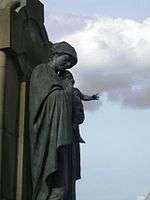
Side view Derby War Memorial
-
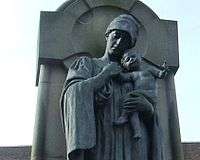
Derby War Memorial
-
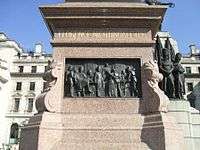
Relief on Florence Nightingale Memorial
-

Another view of relief on Florence Nightingale Memorial
-
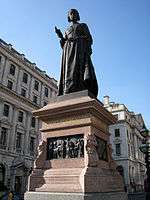
Statue of Florence Nightingale
-
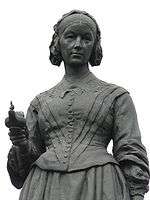
Florence Nightingale monument London closeup
-

Florence Nightingale and Sidney Herbert, 1st Baron Herbert of Lea
-
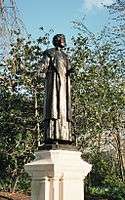
Emmeline Pankhurst Memorial, Westminster
-
Louisa Brandreth Aldrich-Blake, Tavistock Square, London
-
Louisa Brandreth Aldrich-Blake, Tavistock Square, London
-
Dartford War Memorial. Image by Clem Rutter of Rochester Kent
-
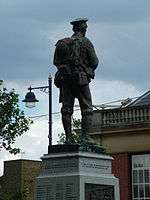
Dartford War Memorial seen from the rear.
-

Bury St Edmunds Memorial.
-
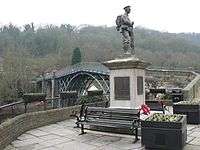
Ironbridge War Memorial.
-
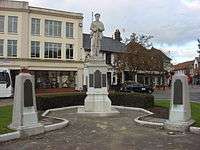
Chesham War Memorial.
-
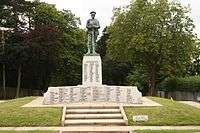
Sevenoaks War Memorial.
-
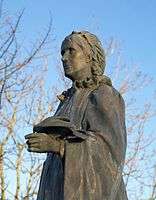
Georgina Baroness Mount-Temple. Lady Mount-Temple, represented here in bronze, was a humanitarian and supporter of animals, involved in the RSPCA and the Anti-Vivisection Society.
References
- 1 2 3 4 5 Arthur George Walker RA. Mapping the Practice and Profession of Sculpture in Britain and Ireland 1851-1951, University of Glasgow History of Art and HATII, online database 2011. Retrieved 19 Aug 2012.]
- ↑ Wolverhampton City Council. Retrieved 22 October 2012
- ↑ Heath Town War Memorial UKNIWM Report. Retrieved 25 October 2012
- ↑ Ironbridge War Memorial UKNIWM Report. Retrieved 25 October 2012
- ↑ Ironbridge Statues Hither and Dither. Website with photographs of Ironbridge War Memorial. Retrieved 26 October 2012
- ↑ Heston War Memorial UKNIWM Report. Retrieved 25 October 2012
- ↑ " For Remembrance and in Honour of Those Who Lost Their Lives in the South African War 1899-1902" by James Gildea. Page 193. Published 1911
- ↑ Bury St Edmunds. South African War Memorial UKNIWM Report. Retrieved 25 October 2012
- ↑ Old Salopians Memorial- WW1 and WW2 and Sir Philip Sidney statue UKNIWM Report. Retrieved 25 October 2012
- ↑ Old Salopians Memorial Statues Hither and Dither. Website with photographs of Ironbridge War Memorial. Retrieved 26 October 2012
- ↑ The Memorial to the 6th Battalion Gordon Highlanders UKNIWM Report. Retrieved 25 October 2012
- ↑ Tablet dedicated to Florence Nightingale UKNIWM Report. Retrieved 25 October 2012
- ↑ Derby War Memorial UKNIWM Report. Retrieved 25 October 2012
- ↑ Bassingbourn and Kneesworth War Memorial UKNIWM Report. Retrieved 25 October 2012
- ↑ Memorial in St Werburgh’s Church UKNIWM Report. Retrieved 25 October 2012
- ↑ Limehouse War Memorial UKNIWM Report. Retrieved 25 October 2012
- ↑ Dartford War Memorial UKNIWM Report. Retrieved 25 October 2012
- ↑ Sevenoaks War Memorial UKNIWM Report. Retrieved 26 October 2012
- ↑ Chesham War Memorial UKNIWM Report. Retrieved 27 October 2012
- ↑ "Christ at the Whipping Post" Tate Britain website. Retrieved 26 October 2012.
- ↑ Roger Payne and William Morris Public Monuments and Sculpture Association. Retrieved 26 October 2012
- ↑ The Thorn Victorian Web. Retrieved 26 October 2012
- ↑ The Thorn (1896), photo Photo in Royal Academy Pictures 1896, London, Cassell and Company Ltd. 1896, cached copy on Internet Archive, retrieved 14 January 2014
- ↑ The Dancer Archived 20 June 2013 at the Wayback Machine. Victorian Web. Retrieved 26 October 2012
- ↑ A Nymph of Diana Victorian Web. Retrieved 26 October 2012
- ↑ Memorial to the late Marchioness of Lothian at Blicking Archived 20 June 2013 at the Wayback Machine. Victorian Web. Retrieved 26 October 2012
- ↑ Memorial to Florence Nightingale Victorian Web. Retrieved 26 October 2012
- ↑ Death of the First-born Archived 20 June 2013 at the Wayback Machine. Victorian Web. Retrieved 26 October 2012
- ↑ St Andrews Backwell The Garnett Memorial. Laurence Tindall (Sculptor). Retrieved 11 September 2011.
- ↑ Ward-Jackson 2011, pp. 382–4
- ↑ American University: John Wesley Memorial in Washington, D.C. DC Memorials. Retrieved 9 June 2010.
- ↑ Lady Mount-Temple Archived 20 December 2012 at the Wayback Machine. St Mary's Church website. Retrieved 26 October 2012
- ↑ National Archives website. Retrieved 26 October 2012
- ↑ Bust of Dame Louisa Aldrich-Blake London Remembers. Retrieved 26 October 2012
External links
| Wikimedia Commons has media related to Arthur George Walker. |